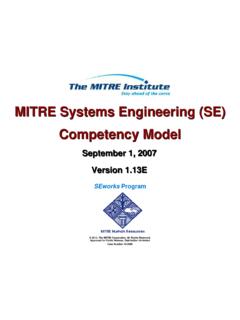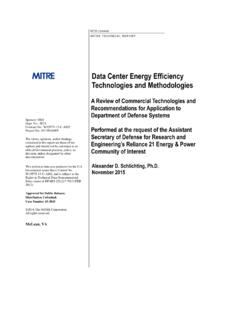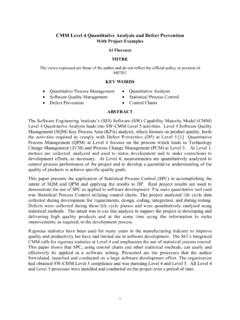Transcription of Supercapacitors: A Brief Overview - Mitre Corporation
1 Approved for Public Release; Distribution Unlimited Case # 06-0667. supercapacitors : A Brief Overview Marin S. Halper March 2006. James C. Ellenbogen MP 05W0000272. Mitre . McLean, Virginia supercapacitors : A Brief Overview Marin S. Halper March 2006. James C. Ellenbogen MP 05W0000272. Mitre Nanosystems Group e-mail: WWW: Sponsor ITIC. Project Nos. 15055224. Dept. W90N. Approved for public release;. distribution unlimited. Copyright 2006 by The Mitre Corporation , McLean, Virginia, USA. All rights reserved. Abstract A new technology, the supercapacitor, has emerged with the potential to enable major advances in energy storage. supercapacitors are governed by the same fundamental equations as conventional capacitors, but utilize higher surface area electrodes and thinner dielectrics to achieve greater capacitances. This allows for energy densities greater than those of conventional capacitors and power densities greater than those of batteries.
2 As a result, supercapacitors may become an attractive power solution for an increasing number of applications. This Brief Overview focuses on the different types of supercapacitors , the relevant quantitative modeling areas, and the future of supercapacitor research and development. i 1. Introduction In response to the changing global landscape, energy has become a primary focus of the major world powers and scientific community. There has been great interest in developing and refining more efficient energy storage devices. One such device, the supercapacitor, has matured significantly over the last decade and emerged with the potential to facilitate major advances in energy storage. supercapacitors , also known as ultracapacitors or electrochemical capacitors, utilize high surface area electrode materials and thin electrolytic dielectrics to achieve capacitances several orders of magnitude larger than conventional capacitors [1-5].
3 In doing so, supercapacitors are able to attain greater energy densities while still maintaining the characteristic high power density of conventional capacitors. This paper presents a Brief Overview of supercapacitors based on a broad survey of supercapacitor research and development (R&D). Following this introduction, in Section 2, background is provided on the fundamentals of conventional capacitors and of supercapacitors . Section 3 presents a taxonomy of supercapacitors , discusses the different classes of such devices, and illustrates how the different classes form a hierarchy of supercapacitor energy storage approaches. Then, Section 4 presents an analysis of the major quantitative modeling research areas concerning the optimization of supercapacitors . Finally, Section 5 provides a prospectus on the future of supercapacitor R&D. An additional key element of the paper is the bibliography, which is organized by topic to assist those who might wish to do further reading and research.
4 1. 2. Background Conventional capacitors consist of two conducting electrodes separated by an insulating dielectric material. When a voltage is applied to a capacitor, opposite charges accumulate on the surfaces of each electrode. The charges are kept separate by the dielectric , thus producing an electric field that allows the capacitor to store energy. This is illustrated in Figure 1. Capacitance C is defined as the ratio of stored (positive) charge Q to the applied voltage V: Q. C= . (1). V. For a conventional capacitor, C is directly proportional to the surface area A of each electrode and inversely proportional to the distance D between the electrodes: A. C = 0 r . (2). D. The product of the first two factors on the right hand side of the last equation is a constant of proportionality wherein 0 is the dielectric constant (or permittivity ) of free space and r is the dielectric constant of the insulating material between the electrodes.
5 The two primary attributes of a capacitor are its energy density and power density. For either measure, the density can be calculated as a quantity per unit mass or per unit volume. The energy E stored in a capacitor is directly proportional to its capacitance: 1. E = CV 2 . (3). 2. In general, the power P is the energy expended per unit time. To determine P for a capacitor, though, one must consider that capacitors are generally represented as a circuit in series with an external load resistance R, as is shown in Figure 1. 2. dielectric + -+ -+ -+ - + -+ -+ -+ - Positive + - Negative -+ -+ -+. Electrode + - Electrode -+ -+ -+. + -+ -+ -+ - + -+ -+ -+ - + -+ -+ -+ - + -+ -+ -+ - + -+ -+ -+ - Load Load Electric Field Resistance Resistance + - Applied Voltage Figure 1. Schematic of a conventional capacitor. 3. The internal components of the capacitor ( , current collectors, electrodes, and dielectric material) also contribute to the resistance, which is measured in aggregate by a quantity known as the equivalent series resistance (ESR).
6 The voltage during discharge is determined by these resistances. When measured at matched impedance (R = ESR), the maximum power Pmax for a capacitor [1-2, 5] is given by: V2. Pmax = . (4). 4 ESR. This relationship shows how the ESR can limit the maximum power of a capacitor. Conventional capacitors have relatively high power densities, but relatively low energy densities when compared to electrochemical batteries and to fuel cells. That is, a battery can store more total energy than a capacitor, but it cannot deliver it very quickly, which means its power density is low. Capacitors, on the other hand, store relatively less energy per unit mass or volume, but what electrical energy they do store can be discharged rapidly to produce a lot of power, so their power density is usually high. supercapacitors are governed by the same basic principles as conventional capacitors.
7 However, they incorporate electrodes with much higher surface areas A and much thinner dielectrics that decrease the distance D between the electrodes. Thus, from Eqs. 2 and 3, this leads to an increase in both capacitance and energy. Furthermore, by maintaining the low ESR characteristic of conventional capacitors, supercapacitors also are able to achieve comparable power densities. Additionally, supercapacitors have several advantages over electrochemical batteries and fuel cells, including higher power density, shorter charging times, and longer cycle life and shelf life [1-3]. Figure 2 provides a schematic diagram of a supercapacitor, illustrating some of the physical features described above. 4. Positive Negative Electrode Electrode + +-- +- - ++-+- - -- +++ - -+. + +--- +- --+. ++. Current ++ - ---- - +- - +-++ Current +. Collector +- - -- +++ - Collector +-+.
8 + -- +++- - ++- +- + --- ++- ++ - ++ ---- - +++ -+ - ++. +- +--- ++- -+. -+. +- +- ++++- - + +-- +- + - Load Separator + -++ ++. Resistance +. + ++ - - - + +- - - - + - + - - - + + ++ + - - + - - -- + -- - - + - - - -+ -- ++ - + + ++ + +. + - Applied Voltage Figure 2. Schematic of an electrochemical double-layer capacitor. 5. The performance improvement for a supercapacitor is shown in Figure 3, a graph termed a Ragone plot. This type of graph presents the power densities of various energy storage devices, measured along the vertical axis, versus their energy densities, measured along the horizontal axis. In Figure 3, it is seen that supercapacitors occupy a region between conventional capacitors and batteries [3]. Despite greater capacitances than conventional capacitors, supercapacitors have yet to match the energy densities of mid to high-end batteries and fuel cells.
9 Thus, much of the literature surveyed for this Overview focuses on developing improved types or classes of supercapacitors to make their energy densities more comparable to those of batteries. These factors and trends are reflected in the taxonomy of supercapacitors presented in the next section. 3. Taxonomy of supercapacitors Based upon current R&D trends, supercapacitors can be divided into three general classes: electrochemical double-layer capacitors, pseudocapacitors, and hybrid capacitors. (See Figure 4.) Each class is characterized by its unique mechanism for storing charge. These are, respectively, non-Faradaic, Faradaic, and a combination of the two. Faradaic processes, such as oxidation-reduction reactions, involve the transfer of charge between electrode and electrolyte. A non-Faradaic mechanism, by contrast, does not use a chemical mechanism. Rather, charges are distributed on surfaces by physical processes that do not involve the making or breaking of chemical bonds.
10 This section will present an Overview of each one of these three classes of supercapacitors and their subclasses, distinguished by electrode material. A graphical taxonomy of the different classes and subclasses of supercapacitors is presented in Figure 4. 6. 107. CAPACITORS. 106. Power Density (W/kg). 105. 104. 103. supercapacitors . 100 BATTERIES. FUEL CELLS. 10. 1. 1 10 100 1000. Energy Density (Wh/kg). Figure 3. Ragone plot of energy storage devices, adapted from [3]. 7. supercapacitors Electric Double- Pseudocapacitors Layer Capacitors Activated Conducting Carbon Aerogels Metal Oxides Carbons Polymers 8. Carbon Nanotubes Hybrid Capacitors Composite Asymmetric Battery-Type Hybrids Hybrids Hybrids Figure 4. Taxonomy of supercapacitors . Electrochemical Double-Layer Capacitors Electrochemical double-layer capacitors (EDLCs) are constructed from two carbon-based electrodes, an electrolyte, and a separator.









